News
How to Make a Flag: The Complete DIY & Pro Guide
Flags are more than fabric—they’re symbols of pride, identity, and creativity. Whether you’re crafting a porch house flag, a garden display, a tailgate banner/pennant, or a DIY school project, learning how to make a flag (including custom flag printing, bunting, and kid-safe builds) is both fun and affordable. This guide covers DIY flag paths from fast paper to durable dye-sublimation polyester, with professional tips from FlagOh to help your flag stand tall and endure sun, wind, and UV.
Decide by Use Case: Where It Hangs, How Far It’s Seen, How It Mounts
Before cutting fabric or grabbing paper, ask: Where will this flag fly—whether it’s a porch display, a pennant flag, or a classroom project? The answer shapes everything—size, material, mounting, and budget.
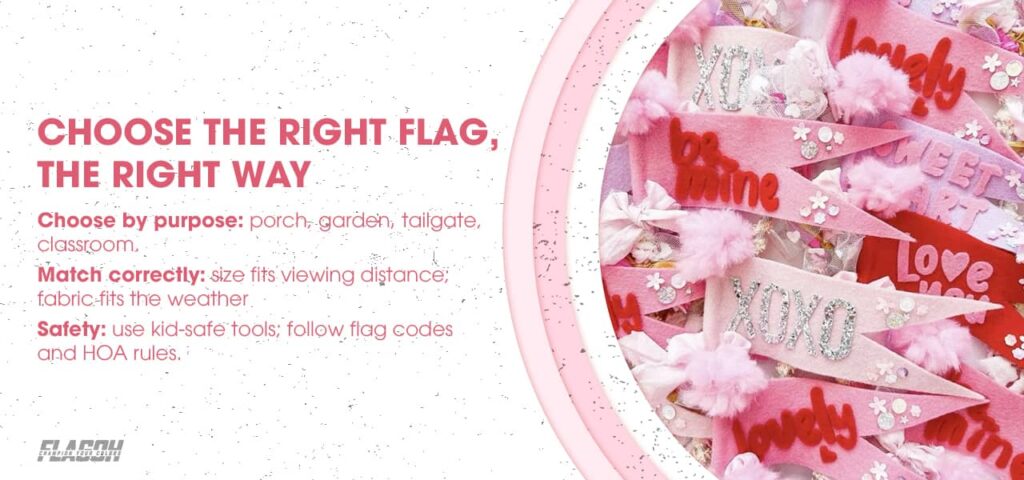
Viewing Distance → Size Rules
A flag should be legible at a glance. Use these quick ratios:
| Flag Size | Ideal Viewing Distance | Common Use |
| 12×18 in (30×45 cm) | 3–5 m (10–16 ft) | Garden, desks, kid projects |
| 2×3 ft (61×91 cm) | 5–8 m (16–25 ft) | Apartments, paddocks |
| 3×5 ft (91×152 cm) | 7–10 m (20–30 ft) | Porches, garages, tailgates |
| 28×40 in (71×102 cm) | 7–9 m (23–30 ft) | House-mounted sleeve flags |
| 36×60 in (91×152 cm) | 10–12 m (30–40 ft) | Large wall displays |
Mounting Contexts & Flagpole Basics
- Sleeves: Slide over porch poles (28×40 in is standard).
- Grommets: Metal eyelets for 3×5 ft outdoor flags.
- Brackets: 30° or 45° angles help flags catch the wind.
- Telescoping Poles: Great for tailgates—collapse for travel.
Durability vs Budget Matrix
- Polyester (150–200 GSM): $10–$15/yard; strong balance of cost + outdoor durability.
- 210D Nylon: $20+/yard; premium, withstands 20+ mph winds.
Safety & Legal Fast Rules
- Use blunt scissors or pre-cut kits for kids.
- Don’t leave flags near open flames.
- When displaying national symbols, review your country’s flag code and any HOA/school policy or municipal bylaws—especially for pole height, bracket placement, and quiet hours.
Decide the flag’s job, match size to distance, pair fabric to weather and budget, and mount safely—build once, fly proudly.
Quick Single-Flag Builds: Paper/Poste & Simple Cloth
Short on time? These three quick builds—paper/poster, simple cloth, and a pennant banner—use common supplies and clear steps so you can go from idea to display in under two hours. Pick the path that fits your budget and where the flag will hang.
Paper/Poster Flag (indoor/temporary, kid-safe)
- Time: 30–45 min • Cost: <$5 • Skill: Beginner
- Size: ~17×22 in (2×2 Letter/A4) or 22×28 in poster board
- Materials: 4× Letter/A4 or 1 poster board; clear/painter’s tape; ⅜–½ in (10–12 mm) dowel or taped paper tube; markers/paint/stickers; blunt scissors; ruler; optional hole punch, short string/ribbon.
- Steps: Make a 2×2 taped panel; add a reinforced 1 in (25 mm) hoist edge; wrap-tape to pole every 2–3 in (5–7 cm); decorate with large, high-contrast shapes; optional leash via two punched holes; optional ribbon/tassel.
Simple Cloth Flag (outdoor/indoor)
- Time: 60–90 min • Cost: $15–$25 • Skill: Beginner–Intermediate
- Sizes: 2×3 ft (61×91 cm) or 12×18 in (30×46 cm)
- Materials: Polyester 150–200 GSM (outdoor) or cotton (indoor); sewing machine or fabric glue/hem tape*; polyester thread; tape measure; fabric shears/rotary cutter; pins/clips; iron; dowel/house pole or garden stand; optional grommet kit.
- Steps (2×3 ft): Cut 24×36 in; double-fold ¼ in (6 mm) hems on top/bottom/fly and stitch (or hem tape/glue); make a 1.5 in (38 mm) sleeve at hoist and stitch; reinforce hoist corners; mount and check drape.
Pennant Banner (Bunting): Decorative String (Not a Single Flag)
- Time: 30–60 min • Cost: $5–$10 • Skill: Beginner
- Pennants: Triangles 8–10 in (20–25 cm) tall; spacing 3–4 in (8–10 cm)
- Materials: Scrapbook paper/cardstock/felt (felt tolerates light moisture); twine/ribbon/bias tape (span + ~24 in / 60 cm for tying); hole punch or sewing machine; scissors/rotary cutter; ruler/triangle template.
- Steps: Cut a triangle template, trace and cut pennants, then string them by hole-punching (thread twine) or sewing along the top; keep 3–4 in spacing, knot to lock, leave ~12 in at each end to tie, hang with hooks/tape, and use kid-safe tools indoors/under cover.
Keep it simple: size for visibility, choose indoor vs outdoor materials, and mount securely. Start with the paper option for speed, try the cloth build for durability, and use kid-safe tools throughout—then fly it with pride.
Materials & Build Methods Explained
Before you start cutting or sewing, it helps to know what materials and methods actually work for flag making—especially if you’re planning a DIY garden flag. Each option—whether it’s fabric choice, decoration style, or build type—comes with trade-offs in cost, durability, and appearance.
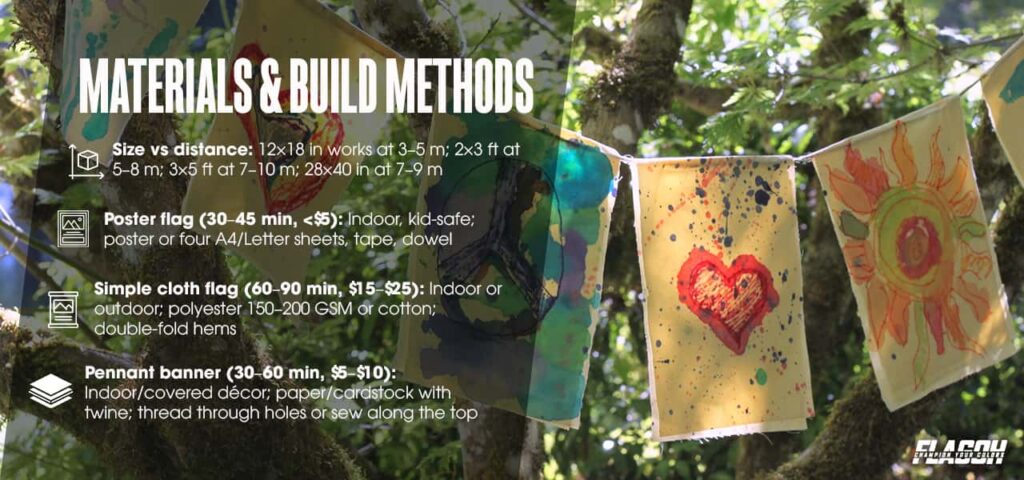
Fabric 101: Cotton, Nylon, Polyester, Blackout/Liner
- Cotton: budget-friendly; best indoors; lower UV resistance.
- Polyester (150–200 GSM): balanced cost/durability; ideal for dye-sublimation prints.
- Nylon 210D (denier): excellent wind performance; quick-dry; 2–3× the outdoor life of cotton.
- Blackout liner: increases opacity for double-sided builds; reduces bleed-through.
Graphics Options: Print, Appliqué/Sew, Heat-Bond/Vinyl
- Print: Fast, full-color, but fades after 12–18 months outdoors.
- Appliqué: Cut fabric shapes stitched on; durable but time-heavy.
- Heat-bond/Vinyl: Affordable, crisp graphics, works with Cricut.
Single- vs Double-Sided Builds
- Single-sided: cheaper, lighter, 50% see-through.
- Double-sided: two panels + liner, readable both ways, 2× weight.
Pick the fabric and finish that balance strength, look, and lifespan so your flag fits its use and stays looking sharp.
Printing Methods & Color Management (Dye-Sub, Screen, HTV, ICC)
Getting the look you want on a flag often comes down to how the design is applied. From professional printing techniques to home craft tools, each method affects color quality, durability, and cost in different ways.
Printing Methods: Dye-Sub, Inkjet, Screen & HTV
- Dye-sublimation (poly only): Heat-bonded dyes → vivid, wash-fast; best for outdoor polyester flags.
- Pigment inkjet (home-friendly): Use outdoor-rated inks; laminate or heat-seal edges to extend life.
- Screen printing (volume/spot colors): Very durable inks; higher setup cost—great for large runs.
- HTV + plotter (Cricut/Silhouette): Cut letters/logos and press (or iron). Adds opacity for single-sided flags; can layer if overall weight stays reasonable.
Color & File Prep: RGB→CMYK, ICC, Pantone
- Design on screen in RGB, then convert to CMYK with the printer’s ICC profile for accurate output.
- For exact brand hues, request Pantone matching (aka “colour management” in the EU).
- Match method to management: Pick the print process first, then set color profiles so results stay sharp and consistent.
Pick the method for the job—dye-sub for outdoor polyester, inkjet for quick home prints, screen for volume, HTV for sharp logos. Manage color: convert RGB→CMYK with ICC, and use Pantone when exact brand hues matter.
Step-by-Step Builds
Once you’ve chosen your materials and design, it’s time to bring the flag to life—this is where how to make a flag becomes practical. These build guides walk you through simple steps to go from loose fabric or paper to a finished piece you can display with pride.
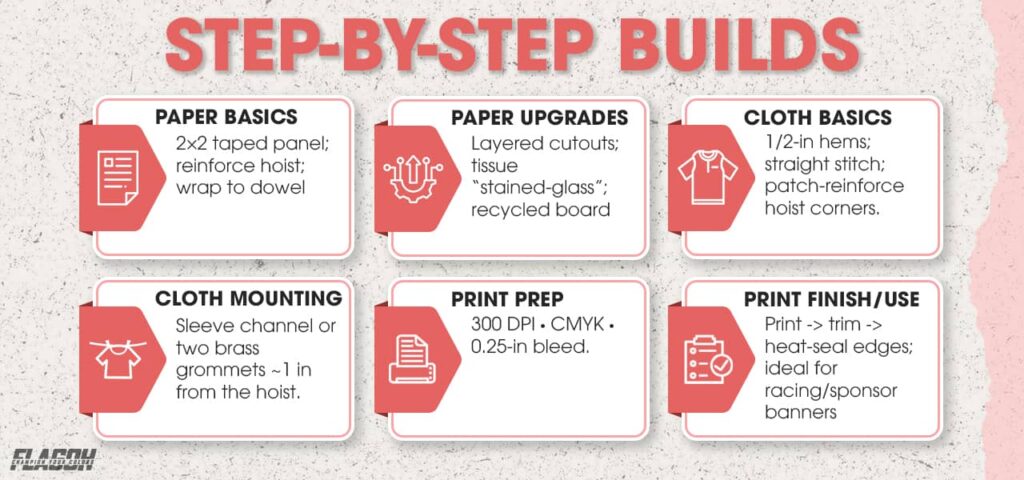
Paper/Poster Flag (Tube Pole + Taped Panel)
Creative & Practical Upgrades (one quick set):
- Layered texture: Add cut shapes (stars, stripes, mascots) on the base for a bold, dimensional look.
- “Stained-glass” glow: Cut small windows and back them with tissue paper so the flag lights up in sunshine.
- Eco base: Swap paper for recycled cardboard—it holds shape in the wind and takes chalk or paint beautifully.
- Secure & comfy: Punch two holes along the fold, thread the string to tie around the dowel, and wrap the grip with fabric/athletic tape.
- More visibility: Tie a tassel or ribbon at the pole top for movement that pops in crowds.
Sewn Cloth Flag (Hem, Reinforced Corners, Sleeve/Grommets)
- Fold ½ in hem, sew a straight stitch.
- Reinforce corners with patches.
- Add 2 brass grommets (about 1 in from edges).
Printed Poly/Vinyl Flag (Home Printer or Local Shop)
- File size: 300 DPI, CMYK, bleed margin 0.25 in.
- Print → trim → heat-seal edges.
- Works well for racing flags or sponsor banners.
Follow the steps and choose the build that fits your needs—paper, sewn cloth, or printed—so the project stays manageable and personal.
Hardware & Mounting: Poles, Grommets, Sleeves, Brackets, Anti-Wrap
Even the best-made DIY flag needs the right setup to fly properly. Mounting hardware and anti-wrap add-ons work together to keep your flag secure and legible in different environments.
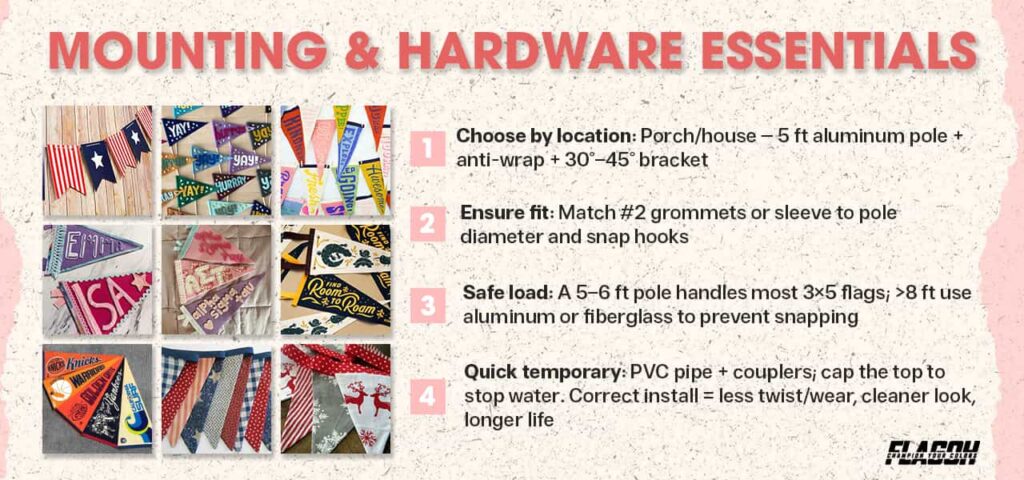
Choose Hardware by Location
- Porch/House flag: 5 ft aluminum pole with anti-furl kit; 30°/45° bracket; match #2 grommet or sleeve fit.
- Tailgate: 10–12 ft telescoping fiberglass pole; secure with base mount; check wind exposure on highways.
- Fence/Wall: stainless hardware; confirm pole diameter vs snap-hooks; consider rope & toggle for traditional banners.
Safe Installation & Load Basics
- Poles 5–6 ft handle most 3×5 flags.
- Over 8 ft? Go with aluminum or fiberglass to avoid snapping.
DIY Flagpole Quick-Start
- PVC pipe + couplers → cheap temporary solution.
- Cap top to avoid water pooling
Match hardware to location and install correctly to prevent twist and wear—your flag will last longer and look cleaner.
Flag Hardware Anatomy & Specs
Behind every well-flying flag is a set of small but important parts that work together. From ropes and grommets to finials and anti-wrap kits, knowing what each piece does helps you choose the right setup and avoid common problems like twisting, noise, or wear.
Rope & Toggle, Halyard, Cleat, Truck & Finial — extra know-how
- Rope choice: A low-stretch polyester halyard (braided) resists UV better than nylon and keeps flags from creeping down over time.
- Quiet setup: Add a small shock cord or foam spacer where the halyard meets the pole to stop nighttime clatter.
- Final tips: Ball finials shed rain and protect the halyard from snagging. In storm seasons, avoid tall conductive finials or add proper lightning protection.
Grommet Sizes & Pole Diameter — practical upgrades
- Spur vs plain washers: Spur grommets bite into fabric and hold better on outdoor flags than plain washers.
- Measure once: Check the outside diameter (OD) of the pole and the snap-hook opening so the hardware closes fully without rattling.
- Swivels help: A stainless swivel shackle between snap hook and grommet cuts twist and reduces edge wear on long, windy days.
Anti-Furl / Anti-Wrap Kits — setup that actually works
- Placement: Install the ring(s) just above the sleeve or top grommet, leaving 2–3 cm (≈1 in) of clearance so the header can move but not spin freely.
- Two-point control: Pair a top anti-furl ring with a lower guide clip; controlling both ends keeps graphics facing out more consistently.
- Seasonal check: Inspect sleeves, clips, and rings monthly for UV cracking; replace plastic components that go chalky or brittle.
Matched, well-maintained hardware keeps the flag secure and sharp—and smart upgrades extend pole and fabric life.
Design & Build Planner: Visibility, Time & Budget
Strong flags pair clear visuals with a plan you can execute. Use these cues to keep graphics legible on any DIY flag, then pick the build that fits your time, cost, and skill.
Big Type & Simple Geometry
- Use 2–3 high-contrast colors for instant recognition.
- Add a 2–4 mm outline to lettering to prevent washout.
- Favor bold sans-serif over thin fonts for distance readability.
File Setup Basics
- Vectors (.AI, .SVG) scale cleanly; rasters (.JPG, .PNG) should be 300 DPI at print size.
- Convert to CMYK with the printer’s ICC profile; request Pantone matches for brand accuracy.
- For HTV (Cricut/Silhouette), RGB mockups are fine—test a small swatch first.
Build Time & Budget Snapshot
| Build | Time | Cost | Skill |
| Paper Flag | 30 min | <$5 | Beginner |
| Cloth Flag | 60–90m | $15–$25 | Intermediate |
| Double-Sided Nylon | 2–3 h | $30–$50 | Advanced |
Lock in a clean design, prep files correctly, and choose a path that matches your resources. The right mix of legibility choices and a realistic build plan delivers a flag that looks crisp—and gets finished on schedule.
Care, Weatherproofing & Repairs
A flag lasts as long as you care for it. Simple habits—gentle cleaning, dry storage, UV protection, and quick touch-ups—do more for lifespan than any single upgrade. Think routine, not rescue.
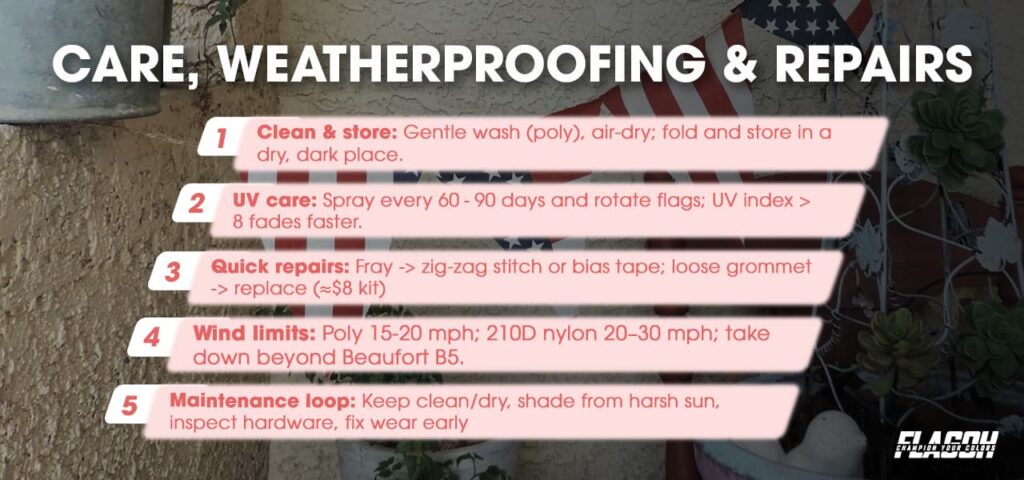
Cleaning & Storage
- Wash polyester flags on a gentle cycle, air-dry.
- Store folded in a dry, dark space.
- For high UV index regions, apply UV-protectant spray every 60–90 days and rotate flags to extend color life.
Re-Stitch, Re-Grommet, Edge Tape
- Fray? Sew zig-zag stitch or add bias tape.
- Loose grommet? Replace with $8 hand tool kit.
Weather & Performance Thresholds (Wind, UV, Beaufort)
- Wind rating: Lightweight polyester flags handle steady 15–20 mph (24–32 km/h); 210D nylon tolerates 20–30 mph (32–48 km/h).
- Beaufort scale: B4 (moderate breeze) is ~13–18 mph; B5 (fresh breeze) 19–24 mph—consider taking flags down beyond B5 gusts.
- UV index: Above 8, expect faster fade. Apply UV-safe sprays and rotate flags to extend life.
Build a small maintenance loop: keep it clean and dry, shield it from harsh sun, inspect hardware, and fix wear early. Take the flag down in rough conditions and it’ll stay brighter, fly better, and cost you less over time.
Troubleshooting & Toolkit: Quick Fixes and What to Use
When something looks off, the right tool and a one-minute fix can save the day. Use this quick guide to match common problems with simple solutions and the gear that makes them easy.
Quick fixes by symptom
- Edges curling: add a narrow hem or press with light steam.
- Creases/wrinkles: mist lightly, then iron on low with a pressing cloth.
- Flag sagging on the pole: fit anti-wrap rings or a lower guide clip.
- Colors looking dull: rotate displays, shelter during peak sun, plan a refresh at 12–18 months.
Core toolkit (at a glance)
| Minimum Kit | Nice-to-Have |
| Fabric shears | Rotary cutter + self-healing mat |
| All-purpose thread | UV-resistant polyester thread |
| Dowels | Telescoping poles |
| Tape/glue | Sewing machine + grommet press |
Sourcing tips
- Fabric: local craft shops or JoAnn’s, typically $8–$12/yard.
- Hardware: home-improvement stores or online kits.
- Custom printing: print services like VistaPrint or pro makers such as FlagOh.
Keep a small kit handy and fix issues early to restore shape—and keep the flag flight-ready longer.
Mini-FAQ
You’ll also find quick pointers on metric–imperial conversions, when it’s smart to take a flag down for high wind or UV, and which hardware upgrades prevent twist. If you’re choosing between DIY and custom printing, we flag the moments where pro finishing (stitching, dye-sub color control) is worth it.
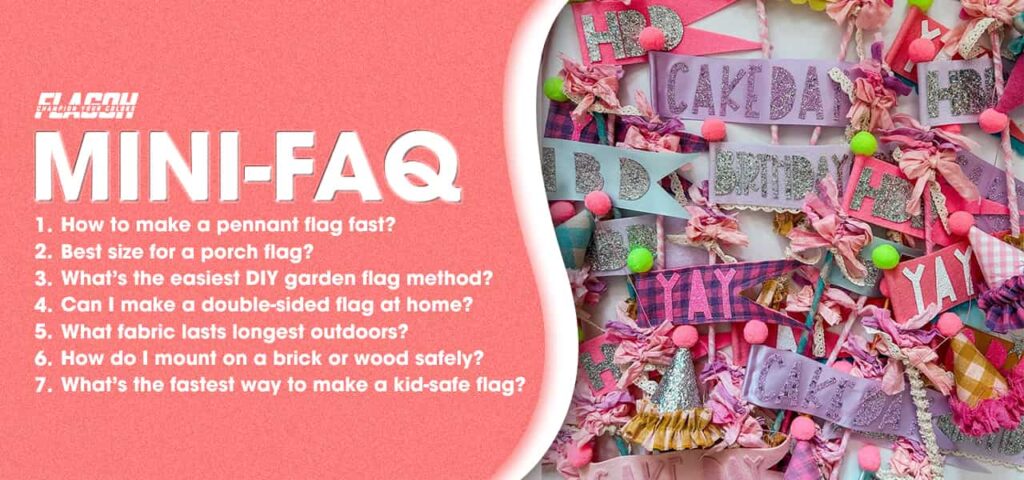
How to make a pennant flag fast?
Cut 8–10 in triangles, fold a 0.5 in edge, tape or stitch, punch holes, and string. For outdoors, use polyester and add a top tassel for visibility.
Best size for a porch flag?
28×40 in fits most house brackets.
What’s the easiest DIY garden flag method?
Sew a 1.5 in sleeve on a 12×18 in polyester panel, hem edges, slide onto a garden stand, and add an anti-wrap ring to prevent twisting.
Can I make a double-sided flag at home?
Yes—sew two panels back-to-back with a liner.
What fabric lasts longest outdoors?
210D nylon or 200 GSM polyester.
How do I mount on a brick or wood safely?
Use masonry anchors for brick; lag screws for wood.
What’s the fastest way to make a kid-safe flag?
Paper + tape + dowel—done in 30 minutes, no sharp tools.With these answers in hand, you can skip the guesswork and focus on making a flag that’s right for your space, your budget, and your purpose. Simple solutions often make the biggest difference
You now have a clear path from idea to finished flag—start simple with a DIY garden flag, then scale up as you master how to make a flag that stands up to sun, wind, and rain. Choose the build that fits your timeframe, apply the right finish, and keep it in shape with simple upkeep. When you’re ready for pro-grade color and stitching, FlagOh has options that look sharp and last.
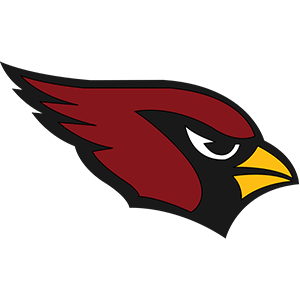 Arizona Cardinals Flag
Arizona Cardinals Flag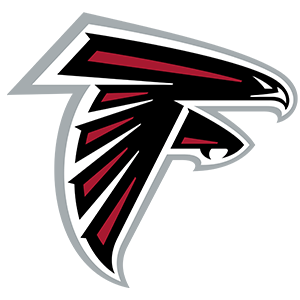 Atlanta Falcons Flag
Atlanta Falcons Flag Baltimore Ravens Flag
Baltimore Ravens Flag Buffalo Bills Flag
Buffalo Bills Flag Carolina Panthers Flag
Carolina Panthers Flag Chicago Bears Flag
Chicago Bears Flag Cincinnati Bengals Flag
Cincinnati Bengals Flag Cleveland Browns Flag
Cleveland Browns Flag Dallas Cowboys Flag
Dallas Cowboys Flag Denver Broncos Flag
Denver Broncos Flag Detroit Lions Flag
Detroit Lions Flag Green Bay Packers Flag
Green Bay Packers Flag Houston Texans Flag
Houston Texans Flag Indianapolis Colts Flag
Indianapolis Colts Flag Jacksonville Jaguars Flag
Jacksonville Jaguars Flag Kansas City Chiefs Flag
Kansas City Chiefs Flag Las Vegas Raiders Flag
Las Vegas Raiders Flag Los Angeles Chargers Flag
Los Angeles Chargers Flag Los Angeles Rams Flag
Los Angeles Rams Flag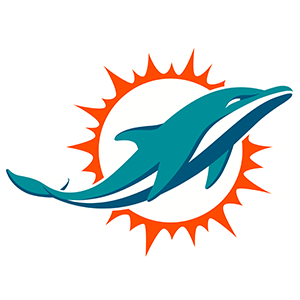 Miami Dolphins Flag
Miami Dolphins Flag Minnesota Vikings Flag
Minnesota Vikings Flag New England Patriots Flag
New England Patriots Flag New Orleans Saints Flag
New Orleans Saints Flag New York Giants Flag
New York Giants Flag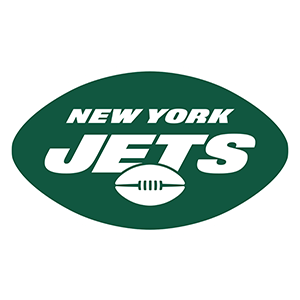 New York Jets Flag
New York Jets Flag Philadelphia Eagles Flag
Philadelphia Eagles Flag Pittsburgh Steelers Flag
Pittsburgh Steelers Flag San Francisco 49ers Flag
San Francisco 49ers Flag Seattle Seahawks Flag
Seattle Seahawks Flag Tampa Bay Buccaneers Flag
Tampa Bay Buccaneers Flag Tennessee Titans Flag
Tennessee Titans Flag Washington Commanders Flag
Washington Commanders Flag Arizona Diamondbacks Flag
Arizona Diamondbacks Flag Atlanta Braves Flag
Atlanta Braves Flag Baltimore Orioles Flag
Baltimore Orioles Flag Boston Red Sox Flag
Boston Red Sox Flag Chicago Cubs Flag
Chicago Cubs Flag Chicago White Sox Flag
Chicago White Sox Flag Cincinnati Reds Flag
Cincinnati Reds Flag Cleveland Guardians Flag
Cleveland Guardians Flag Colorado Rockies Flag
Colorado Rockies Flag Detroit Tigers Flag
Detroit Tigers Flag Houston Astros Flag
Houston Astros Flag Kansas City Royals Flag
Kansas City Royals Flag Los Angeles Angels Flag
Los Angeles Angels Flag Los Angeles Dodgers Flag
Los Angeles Dodgers Flag Miami Marlins Flag
Miami Marlins Flag Milwaukee Brewers Flag
Milwaukee Brewers Flag Minnesota Twins Flag
Minnesota Twins Flag New York Mets Flag
New York Mets Flag New York Yankees Flag
New York Yankees Flag Oakland Athletics Flag
Oakland Athletics Flag Philadelphia Phillies Flag
Philadelphia Phillies Flag Pittsburgh Pirates Flag
Pittsburgh Pirates Flag San Diego Padres Flag
San Diego Padres Flag San Francisco Giants Flag
San Francisco Giants Flag Seattle Mariners Flag
Seattle Mariners Flag St. Louis Cardinals Flag
St. Louis Cardinals Flag Tampa Bay Rays Flag
Tampa Bay Rays Flag Texas Rangers Flag
Texas Rangers Flag Toronto Blue Jays Flag
Toronto Blue Jays Flag Washington Nationals Flag
Washington Nationals Flag Atlanta Hawks Flag
Atlanta Hawks Flag Boston Celtics Flag
Boston Celtics Flag Brooklyn Nets Flag
Brooklyn Nets Flag Charlotte Hornets Flag
Charlotte Hornets Flag Chicago Bulls Flag
Chicago Bulls Flag Cleveland Cavaliers Flag
Cleveland Cavaliers Flag Dallas Mavericks Flag
Dallas Mavericks Flag Denver Nuggets Flag
Denver Nuggets Flag Detroit Pistons Flag
Detroit Pistons Flag Golden State Warriors Flag
Golden State Warriors Flag Houston Rockets Flag
Houston Rockets Flag Indiana Pacers Flag
Indiana Pacers Flag LA Clippers Flag
LA Clippers Flag Los Angeles Lakers Flag
Los Angeles Lakers Flag Memphis Grizzlies Flag
Memphis Grizzlies Flag Miami Heat Flag
Miami Heat Flag Milwaukee Bucks Flag
Milwaukee Bucks Flag Minnesota Timberwolves Flag
Minnesota Timberwolves Flag New Orleans Pelicans Flag
New Orleans Pelicans Flag New York Knicks Flag
New York Knicks Flag Oklahoma City Thunder Flag
Oklahoma City Thunder Flag Orlando Magic Flag
Orlando Magic Flag Philadelphia 76ers Flag
Philadelphia 76ers Flag Phoenix Suns Flag
Phoenix Suns Flag Portland Trail Blazers Flag
Portland Trail Blazers Flag Sacramento Kings Flag
Sacramento Kings Flag San Antonio Spurs Flag
San Antonio Spurs Flag Toronto Raptors Flag
Toronto Raptors Flag Utah Jazz Flag
Utah Jazz Flag Washington Wizards Flag
Washington Wizards Flag Anaheim Ducks Flag
Anaheim Ducks Flag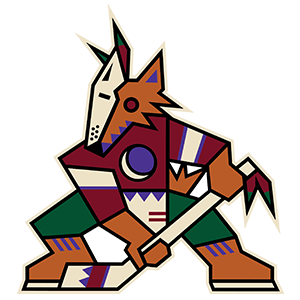 Arizona Coyotes Flag
Arizona Coyotes Flag Boston Bruins Flag
Boston Bruins Flag Buffalo Sabres Flag
Buffalo Sabres Flag Calgary Flames Flag
Calgary Flames Flag Carolina Hurricanes Flag
Carolina Hurricanes Flag Chicago Blackhawks Flag
Chicago Blackhawks Flag Colorado Avalanche Flag
Colorado Avalanche Flag Columbus Blue Jackets Flag
Columbus Blue Jackets Flag Dallas Stars Flag
Dallas Stars Flag Detroit Red Wings Flag
Detroit Red Wings Flag Edmonton Oilers Flag
Edmonton Oilers Flag Florida Panthers Flag
Florida Panthers Flag Los Angeles Kings Flag
Los Angeles Kings Flag Minnesota Wild Flag
Minnesota Wild Flag Montreal Canadiens Flag
Montreal Canadiens Flag Nashville Predators Flag
Nashville Predators Flag New Jersey Devils Flag
New Jersey Devils Flag New York Islanders Flag
New York Islanders Flag New York Rangers Flag
New York Rangers Flag Ottawa Senators Flag
Ottawa Senators Flag Philadelphia Flyers Flag
Philadelphia Flyers Flag Pittsburgh Penguins Flag
Pittsburgh Penguins Flag San Jose Sharks Flag
San Jose Sharks Flag Seattle Kraken Flag
Seattle Kraken Flag St. Louis Blues Flag
St. Louis Blues Flag Tampa Bay Lightning Flag
Tampa Bay Lightning Flag Toronto Maple Leafs Flag
Toronto Maple Leafs Flag Vancouver Canucks Flag
Vancouver Canucks Flag Vegas Golden Knights Flag
Vegas Golden Knights Flag Washington Capitals Flag
Washington Capitals Flag Winnipeg Jets Flag
Winnipeg Jets Flag Auburn Tigers Flag
Auburn Tigers Flag Clemson Tigers Flag
Clemson Tigers Flag Florida Gators Flag
Florida Gators Flag Florida State Seminoles Flag
Florida State Seminoles Flag Michigan Wolverines Flag
Michigan Wolverines Flag Nebraska Cornhuskers Flag
Nebraska Cornhuskers Flag Notre Dame Fighting Irish Flag
Notre Dame Fighting Irish Flag Ohio State Buckeyes Flag
Ohio State Buckeyes Flag Oklahoma Sooners Flag
Oklahoma Sooners Flag Oregon Ducks Flag
Oregon Ducks Flag Penn State Nittany Lions Flag
Penn State Nittany Lions Flag South Carolina Gamecocks Flag
South Carolina Gamecocks Flag Tennessee Volunteers Flag
Tennessee Volunteers Flag Texas A&M Aggies Flag
Texas A&M Aggies Flag Texas Longhorns Flag
Texas Longhorns Flag USC Trojans Flag
USC Trojans Flag